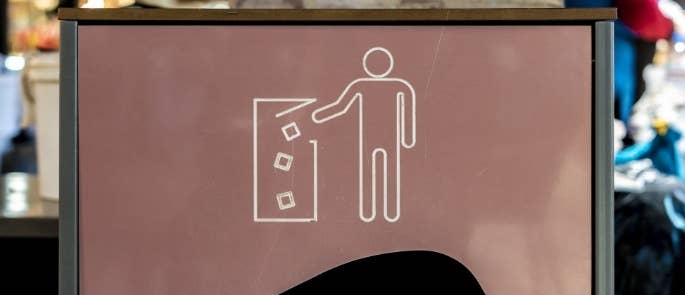How to Improve Sustainability in Restaurants
Restaurants were once able to sell themselves with great menus alone. But nowadays, as concern over climate change and damaged ecosystems filters through consumer consciousness, customers want their pounds to go beyond the bill and towards restaurant sustainability.

Many people feel overwhelmed and powerless to help the planet, but when restaurants take a stand to act more sustainably, they give customers the power to do so too in their everyday life. This heavily influences people’s decisions when eating out. If they’re choosing between two similar eateries but one offers sustainable dining, why wouldn’t they pick the one that saves two birds with one stone?
Making the switch to sustainable practices is therefore not only sensible for doing your part for the planet, but it also makes solid business sense. If you’re unsure of where to start, have a read of this guide for advice. It’ll help you move your business forward into a profitable, eco-friendly future.
What Does Restaurant Sustainability Mean?
Restaurant sustainability refers to when food businesses minimise their impact on the planet, specifically by addressing issues like sustainable farming, their carbon footprint, shortening their supply chain, food wastage, packaging, water and energy consumption, recycling, and more.
Not only does restaurant sustainability mean taking part in helping the environment, but it also means giving customers the opportunity to contribute to these positive efforts. People do decide where to dine based on a business’s values these days. It maximises their money’s mileage and makes them feel like they’re making a difference.

In fact, a survey carried out on behalf of the Sustainable Restaurant Association revealed that over 80% of respondents said that sustainability had been a deciding factor when choosing where to go eat. Another survey, produced by CGA in association with UKHospitality, found that over four in five respondents (83%) expect hospitality brands to take part in sustainable practices, and 41% even said they’d be willing to pay more for sustainable dining.
Being sustainable is therefore more than just a fad or a nice extra: it’s a necessity for satisfying the needs of the current and future generations of diners. If you want customers to pick you over the competition, you’ve got to show that they’re paying for more than just their plate.
Benefits of Sustainability in Restaurants
Aside from the obvious positive that is supporting the environment, becoming a sustainable restaurant brings a variety of benefits to your business. These make adopting a sustainable strategy a worthwhile investment for your business.
Have a look at these 7 benefits you may gain from sustainability practices:
1. Brand loyalty.
When your restaurant’s values align with your customers, they are much more likely to return for seconds. They’ll feel like their money contributed to a positive difference in the world and it’ll bring a greater sense of enjoyment and fulfilment to their outing. Chances are they’ll also spread the word, which is one of the most powerful forms of advertisement.
2. Growth of customer-base.
By sharing your sustainability strategy with the public, people will feel more compelled to at least try your restaurant and at most become loyal customers. You may also find yourself appealing to a broader range of people, such as if you have a range of vegetarian and vegan options in your menu.
3. Increased profits and recovered costs.
With the increase you may gain in your customer base, you’ll naturally find your restaurant’s profits increasing. Meanwhile, the sustainable practices themselves, such as minimising waste, will help you to reduce lost earnings.

4. Employee engagement.
Not only do people want to spend their money in sustainable ways, but they want to earn it sustainably too. Having a strong social conscience can significantly boost staff morale, motivation, and retention, as they’ll feel proud that their work contributes to a positive cause. It can also make them more committed to your brand. Even if they eventually go to work elsewhere, they’ll likely return as a customer.
5. Improved awareness.
Although the push for sustainability is prominent in the media these days, some people are unaware of the facts and how make a real change. Your sustainable practices can act as a positive and inspiring example for those who are unsure of where to start and why it’s an important issue. Even something as simple as including facts on the menu is enough to get people thinking.
6. A better menu.
Speaking of your menu, sustainable food sourcing can actually lead to a much more refined, varied, and high-quality menu. It may cost a little extra to improve your ingredients, but as we learnt earlier, customers are more than willing to pay for sustainable dining.
7. Improving your supply chain.
One sustainable strategy involves shortening your supply chain to reduce your carbon footprint. Not only can this give you greater visibility of the chain and help to prevent food fraud (which can seriously cost your business), but it also resonates with a lot of customers who want to support local businesses and communities. It can also improve the quality of ingredients. This in turn can leave diners feeling even more satisfied with their meal and more likely to recommend and return.
So, how can you gain all these benefits? Luckily, implementing sustainability strategies is easier than you may think.
8 Ways to Improve Your Restaurant’s Sustainability
There’s a wealth of restaurant sustainability trends you can follow right now, as an increasing number of businesses realise that they need to do their part for the environment and need to stay competitive in the industry.

Here are 8 ways your restaurant can effectively improve its sustainability strategy. They range from quick and simple starting points to long-term investments:
1. Start with small wins.
All restaurants can easily take some small first steps to get the sustainability ball rolling:
- Talk to your suppliers about cutting down the packaging they send produce in, or look for one that will. Can you get your fruit and vegetable delivery in reusable crates? Where possible, work with reusable containers to eliminate disposable and recyclable packaging altogether.
- Print menus on recycled paper and cut down on printed receipts. Does your restaurant print specials out every day? Consider writing them on chalk boards instead. Also, many POS systems can send digital receipts to customers, so you could ask if they’d like it emailed rather than printed.
- Replace paper napkins with linen ones. Although this creates an added laundry expense, it’s still better than thousands of paper napkins ending up in landfill.
- Use biodegradable bin bags for unavoidable waste. Standard bin bags can take decades to decompose, whereas biodegradable ones can decompose in a matter of months or a couple of years at most.
- Swap out non-recyclable packaging for reusable and recyclable materials. For example, ditch any cling film used to cover food and any single use plastics and polystyrene boxes if your restaurant also provides takeaway service. You could even encourage customers to return used containers, such as by offering them a bit of money back if they do.
- Encourage people to watch their water use. Water has to go through a rigorous treatment process, which contributes massively to carbon emissions. Cutting down on how much you waste is therefore an easy yet excellent win. Consider installing motion sensor taps to stop them from running when they don’t need to.
- Cut down energy usage. Have a walk around your premises and think about where you can save energy. Do the heating and lighting need to be on all night? Installing automated lights and encouraging staff to turn things off at the end of a night can help with this. You could even implement an energy management system to track usage and identify areas of waste. Also, consider looking for more eco-friendly energy providers.
- Maintain equipment. Thoroughly cleaning and maintaining all your equipment and appliances ensures they run as efficiently as possible.

2. Minimise your carbon mileage.
Look at using local suppliers and seasonal produce to minimise the carbon trail that’s left after every stock delivery. Doing so also has the added benefit of giving you better quality ingredients, as they may be picked or produced the same day. You can do the same thing with your waste and recycling collectors: swap to those that operate locally. Also, see if any of your providers do anything to offset their carbon emissions.
3. Remember to recycle.
Ideally, you’ll cut down your material wastage and minimise the need for recycling, but it’s often unavoidable. Make sure you’ve got the necessary bins to cover all the recyclable waste you produce – whether it’s tin, glass, plastic, or cardboard. Also, ensure that everyone knows to separate it if needed. Talk with your waste collectors if there’s anything that’s not covered. You might realise there are other types of waste they can recycle, such as food.
Want to learn more? Read our dedicated article about Recycling in the Hospitality Industry.
4. Reduce food waste.
According to WRAP statistics, Hospitality and Food Services produce 2.87 million tonnes of waste (including food, packaging, and other non-food waste) every year. Less than half of it is recycled. Of this amount, over 900,000 tonnes is food, 75% of which was avoidable and edible, and restaurants are responsible for almost 200,000 tonnes of it. To put that in perspective, the average bin lorry carries between 10-20 tonnes of waste.
Such a significant level is a huge strain on our planet, as landfills are literally bursting at the seams. Plus, transferring and processing waste leaves a huge carbon footprint behind.

Restaurant waste can often be attributed to poor stock management and menu portioning. These are both easily resolved with care and consideration. You should therefore analyse your menu and the portions you serve for each dish.
For example, are there any dishes that you’ve noticed a lot of people don’t finish? Some restaurants are starting to offer multiple portion sizes so people can choose what they feel able to eat. Are there items on the menu that aren’t often ordered and that you end up throwing away ingredients for? Either cull these dishes from the menu and stop ordering the ingredients, or repurpose the ingredients into other recipes.
Want more tips for minimising food waste? Check out our dedicated article that looks at 17 Ways to Reduce Food Waste in Your Restaurant.
5. Waste no waste.
In a similar vein to the last point, you should also look for ways to prevent waste from going to waste. For example, if you have leftover ingredients, some restaurants join schemes where they can sell them cheaply or donate them. Others invite the homeless to come at the end of the day. Finding a waste collector that takes food waste is also a viable option.
You could even set up a compost garden to grow your own produce. A herb garden or potato patch outside the restaurant can be a great conversation starter, a stand-out feature of your restaurant, and a demonstration of your commitment to sustainability.
6. Add more vegetarian and vegan options.
Unfortunately, most livestock farming and fishing practices have become extremely unsustainable and damaging to the environment. Whether it’s greenhouse gas emissions, mass deforestation, ocean pollution, water contamination, and excessive water usage, the impact that animal agriculture has is now on the radar of many businesses. Selling more vegetable-based dishes can help lower your contribution to this problem tremendously.

Adding vegetarian and vegan dishes also comes with the added bonus of attracting a rapidly-growing consumer base, who are particularly environmentally conscious. Their decision to eat at your restaurant will be heavily influenced by your sustainable practices. Make sure you clearly label vegan or vegetarian dishes on the menu, otherwise they may not feel confident to order.
7. Upgrade equipment to be eco-friendly.
You should consider which appliances and equipment in your restaurant can be swapped for eco-friendly alternatives. Keep an eye out for those with energy star ratings. Although they can cost more than non-eco products, it’s an investment. You may even find that, in the long run, you save money on your energy bill.
Plus, you can offset costs in other ways, such as by charging a little bit more for your sustainable practices. Just make sure you’re upfront about this with diners – they’re willing to spend the extra when they know why.
8. Publicise your efforts.
While your sustainability efforts will be making a massive contribution to the environment, you don’t need to be completely humble about it and say nothing. Let customers know on social media and in the restaurant what part you’re playing in helping the planet. Share updates and statistics on your progress and new initiatives.
In fact, restaurant sustainability is such a prominent movement that there is a dedicated association for it, which you can become a member of once you’ve made the right changes. Having this membership is a huge stamp of approval and can really signal to customers that you mean serious business.

When you’re vocal about your steps towards sustainability, it gets customers and staff buzzing and engaged with your brand. You’ll find that this positive reputation is an incredible business booster and your restaurant will likely fill with both new and return customers and positive vibes.
Making a move towards sustainability isn’t an overnight process, both physically and mentally. But it’s well within your business’s interests and is doable when you make realistic, incremental changes. Before long, you’ll find that businesses who neglect sustainable practices become less appealing to the customer. Meanwhile, your commitment to sustainability will make your restaurant stand out on the high street.
What to Read Next:
- Top 8 Skills for a Successful Career in Hospitality
- Running a Restaurant Successfully in 2020
- The Importance of Stocktaking in Hospitality: Guide for Managers
- Daily Opening and Closing Checklist for Restaurants
- Sustainable Food Practices: Choices & Importance
- Upselling Techniques in Restaurants
- Online Food Hygiene Training Courses







